Conference Hotel
Travel - Immigration - Weather - Sightseeing
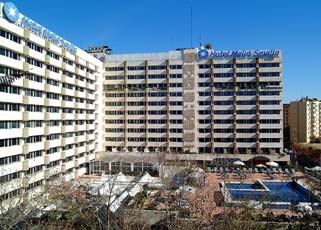
The CDC-ECC'05 will be held at the Melia Sevilla Hotel near the city historical center (see street plan below). Rooms at this hotel and nearby hotels will be offered at reduced rates for people registered at the conference. Hotel reservation web page is already open.
Melia Sevilla Hotel GPS Coordinates:
37º 22’ 40” North
5º 58’ 59’’ West
Melia Sevilla Hotel (4*).
C/ Dr. Pedro Castro, 1. 41004 Sevilla.
Tel: (+34) 954 421 511
Fax: (+34) 952 857 995

- Landmarks:
- 1 Hotel Melia
- 2 Plaza de España
- 3 María Luisa Park
- 4 Faculty of Law
- Streets:
- a Calle Dr. Pedro Castro
- b Avenida de la Borbolla
- c Paseo de las Delicias
- d Avenida de Menéndez Pelayo
- e Avenida de Carlos V
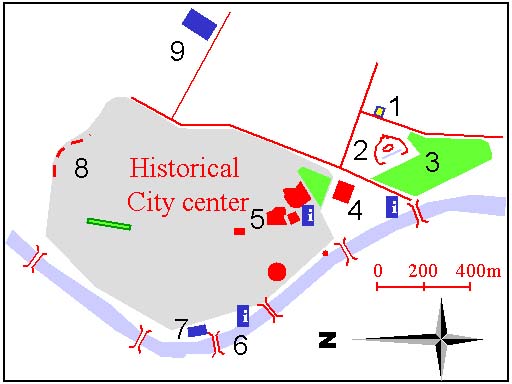
- 1 Hotel Melia
- 2 Plaza de España
- 3 María Luisa Park
- 4 Faculty of Law
- 5 Cathedral
- 6 Guadalquivir River
- 7 Bus Station (Plaza de Armas)
- 8 Macarena
- 9 Train Station (Santa Justa)
Travel
Hotel - Immigration - Weather - Sightseeing
- 1) Travel to Seville
- Train: From Madrid in the AVE train (2h30min). For more info visit the
RENFE Spanish railroads site.
- Airplane: The airport of Seville ("San Pablo" SVQ) has connections with many european cities. Consult the site of
AENA (Spanish aeroports) and of Iberia (main
Spanish airline).
- Car: From Madrid via N-IV (south), From Jerez via N-IV (north), From Malaga via A-92 (west) (see maps)
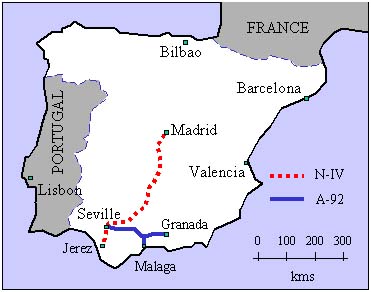
- Train: From Madrid in the AVE train (2h30min). For more info visit the
RENFE Spanish railroads site.
- 2) Getting to the venue Hotel (Hotel Melia Sevilla) from the airport
Taxi: The fare of a taxi from the airport to any point in Seville (and viceversa) is 18 € on week days and 21 € at nigth (after 22:00), Saturdays, Sundays or festivities. The trip to the hotel Melia Sevilla should take around 20 minutes.
Bus: There is a bus service that will take you from the airport to the center of Seville and runs every 30 minutes except for off peak hours (time table and stops). There is a reduced service on Saturdays, Sundays or festivities. The price of the ticket is 2.30 €. Nearest stop (5 minute walk) coming from the airport is "Carlos V (Diego de Riaño)". Pick up for return trip to airport from a stop directly in front of the hotel (Dr. Pedro de Castro).
- 3) Find out more about Seville
- Official bureaus
- Ayuntamiento de Sevilla Seville's city hall
- Turismo de Sevilla Tourism in Seville
- Turismo Andaluz Tourism in Andalusia
- Ayuntamiento de Sevilla Seville's city hall
- Services
Transportes Urbanos de Sevilla Public transport system
- Touristic guides
- Official bureaus
Immigration Requirements
Hotel - Travel - Weather - Sightseeing
- Visas
Please, notice that citizens of certain countries may require a Visa to travel to Spain. Attendees are recommended to contact their nearest Spanish consulate for visa and additional documentation requirements.
Nationals of the following countries may not require a visa for stays of up to 90 days:
EU countries and Andorra, Argentina, Aruba, Australia, Bolivia, Brazil, Brunei, Bulgaria, Canada, Chile, Costa Rica, Croatia, Cyprus, Czech Republic, Ecuador, El Salvador, Estonia, Guatemala, Honduras, Hungary, Iceland, Israel, Japan, Korea (Rep. of), Latvia, Liechtenstein, Lithuania, Malaysia, Malta, Mexico, Monaco, Netherlands Antilles, New Zealand, Nicaragua, Norway, Panama, Paraguay, Poland, Rumania, San Marino, Singapore, Slovak Republic, Slovenia, Switzerland, U.S.A., Uruguay, Vatican City and Venezuela.Additional information can be found at the Foreign Affairs Dept. web-site. This information is provided for your convenience and should always be checked for updates and changes in your Spanish consulate.
- Invitation Letters
Authors needing an official invitation letter (e.g., in order to obtain a visa) can contact the Registration Chair, Carlos Bordons (bordons@esi.us.es). He can provide an invitation letter on behalf of the Joint Conference CDC-ECC'05 for travel to Spain. Invitation letters will only be sent to authors of papers that have been accepted for inclusion in the Technical Program of the CDC-ECC'05.
Weather
Hotel - Travel - Immigration - Sightseeing
- Temperature
The normal daily temperature range for Seville in December is 13 Celsius degrees (55 F) maximum and 4 Celsius degrees (40 F) minimum. - Rain
The rainy season usually begins in October lasting through December. In this month the average rainfall is 76 mm. (3.0 inches) although last December (2004) was particularly dry. - Sunrise (during conference days): 08h30
- Sunset (during conference days): 18h06
- UTC/GMT Offset Standard time zone: UTC/GMT +1 hour (UTC is Coordinated Universal Time, GMT is Greenwich Mean Time)
- Latitude: 37° 24' North
- Longitude: 5° 59' West
- Altitude: 7m (23 ft.)
Sightseeing
Hotel - Travel - Immigration - Weather
Within Sevilla
Places to visit outside Seville
It has hosted two international exhibitions (1929 and 1992) and is the administrative capital of Andalusia. Other places to visit are the neighbourhoods of Triana over the river and Santa Cruz, Sierpes street, the Maestranza bullring, María Luisa park and the riverside walks which are all representative of Seville.
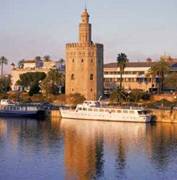
According to legend, Seville was founded by Hercules and its origins are linked with the Tartessian civilisation. It was called Hispalis under the Romans and Isbiliya with the Moors. The high point in its history was following the discovery of America.
Seville lies on the banks of the Guadalquivir and has one of the largest historical centres in Europe, here you can find the Giralda (the minaret of the old mosque), the cathedral (one of the largest in Christendom), and the Alcázar Palace. Part of its treasure includes the Casa de Pilatos, the Town Hall, the Archive of the Indies (where the historical records of the discovery of and trade with the American continent are kept), the Fine Arts Museum (the second largest picture gallery in Spain) , plus many other historical buildings (convents, parish churches and palaces).
As well as all its important monuments and fascinating history, Seville is universally famous for being a lively town. It is the largest town in Southern Spain, the city of Carmen, Don Juan and Figaro and many more operas.
In Seville, you will want to visit the old city, with the Cathedral and the Giralda tower at its heart. (You can climb the ramps inside the tower for a magnificent view of the City). Close by is the royal Mudéjar palace known as the Alcazar with marvellous gardens, and the Santa Cruz quarter, once the home of the Jewish community, a labyrinth of winding, narrow streets, shady flower-filled patios. and picturesque squares, flowered balconies, richly decorated facades.
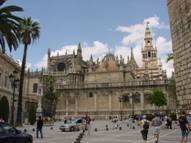

Recommended tapas bars: Don's miss out on the tapas (a brilliant Seville invention). There are more than a thousand bars where the choice of food, is virtually unlimited, from seafood to ham and salami sausage, from vegetable to cheese. Sevillians often eat this way, moving from bar to bar and trying one dish at a time. In the Santa Cruz quarter, try the following bars: Giralda, Modesto, Las Teresas and Casa Robles. In Triana, El Kiosco de las Flores, Casa Cuesta and Bodeguita Sanlúcar. In Santa Catalina, El Rinconcillo, El Bacalao and Quitapesares (Bar Peregill).
Italica(15 km) a Roman city founded by Scipio Africanus in 206 BC where the Emperor Trajan was born. You can visit a well preserved anphitheather and the remains of the streets and houses.
Carmona(30 km) a pleasant Andalusian town with Roman city walls, a Moorish castle (now a Parador), an important Roman Necropolis and many churches.


Jerez(70 km) is famous throughout the world for its wines, named after the town, which the British pronounce "sherry". Jerez is also famous for its fine horses and singers and dancers of flamenco. The distinctive wine in Jerez has been exported for centuries, it was even praised by Shakespeare. It is distinctive because the strong sun gives the grapes a high sugar content. The Spanish word bodega means "cellar", but it has the generical meaning of "wine manufacturer". You can take a guided tour of many Jerez bodegas.

Doñana National Park,(80km) one of Europe's most important wetland areas, and home to an incredible multitude of wildlife in its sand dunes, marshes, pine woods, salt flats and freshwater lagoons. Here is one of Europe's last remaining habitats for the endangered lynx and the rare Spanish Imperial Eagle. The best time to visit is in winter and spring when the park is full of wildfowl. In winter, thousands of geese and ducks arrive from the north, while in spring there are many flocks of breeding birds, including herons, spoonbills and storks.


Monasterio de la Rábida(80 km) is where Columbus stayed between 1491-92 waiting for financial backing from the Catholic Monarchs, Ferdinand and Isabella, for his voyage to the New World. The monastery was constructed in 1412 on the site of a Moorish stronghold; 'rábida' is a Arabic word meaning fortress. The Moorish influence can still be seen in its Mudéjar architecture including a fine cloister. The monastery has a 14th-century Gothic-Mudéjar church where Captain Martín Alonso Pinzón who sailed with Columbus in one of his ships is buried.

Córdoba(150 km) was founded by the Romans and as the highest navigable point of the Guadalquivir River, it became a port city of great importance, used for shipping Spanish olive oil, wine and wheat back to Ancient Rome. The Romans built the mighty bridge crossing the river, now called "El Puente Romano". However, the peak of Cordoba's glory was when it became the capital of the Moorish kingdom of El-Andalus, this was when work began on the Great Mosque, or "Mezquita", which became one of the largest in all of Islam. As well as the unique mosque-cathedral, Cordoba's treasures include the Alcazar, or Fortress, built by the Christians in 1328; the Calahorra Fort, originally built by the Arabs, which guards the Roman Bridge, on the other side of the river from the Mezquita, and the ancient Jewish Synagogue, now a museum. Cordoba's mediaeval quarter, once the home of the Jewish community, is called "La Judería" (The Jewry), a labyrinth of winding, narrow streets, shady flower-filled courtyards and picturesque squares. The famous moorish palace Medina Azahara just north west of Cordoba can also be visited.
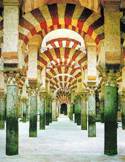
Cádiz(150 km) stands on a peninsula jutting out into a bay, and is almost entirely surrounded by water. Named Gadir by the Phoencians, who founded their trading post in 1100 BC, it was later controlled by the Carthaginians, until it became a thriving Roman port. It attained great splendour in the early 16th century as a launching point for the journeys to America. Cadiz was later raided by Sir Francis Drake, in the struggle to gain control of trade with the New World, and managed to withstand a siege by Napoleon's army.

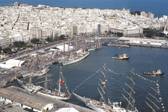
In the early 19th century Cadiz became the bastion of Spain's anti-monarchist, liberal movement, as a result of which the country's first Constitution was declared here in 1812. Some of the city's 18th century walls still stand. Worth a visit are the city's Cathedral and churches of Santa Cruz and San Felipe Neri, which is famous throughout Spain as the place where, in defiance of Napoleon's siege, the provisional government was set up with its own liberal Constitution. Other points of interest are La Santa Cueva, home to several paintings by Goya.
Granada(230 km) is dominated by the Alhambra, arguably the most exciting, sensual and romantic of all European monuments.
It was the palace-fortress of the Nasrid Sultans, rulers of the last Spanish Moorish kingdom and in its construction Moorish art reached a spectacular and serene climax set against the marvelous background of the Sierra Nevada, snowcapped for much of the year. Sierra Nevada offers skiing from November until late May. During the rest of the year the Sierra Nevada National park offers the walker endless hiking opportunities.
